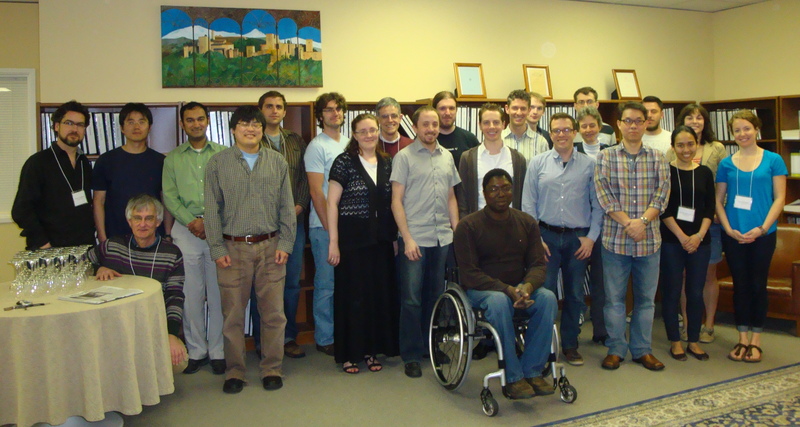Algorithms for lattices and algebraic automorphic forms
May 6 to May 10, 2013
at the
American Institute of Mathematics,
San Jose, California
organized by
Matthew Greenberg,
Markus Kirschmer,
and John Voight
Original Announcement
This workshop will be devoted to
explicit methods for algebraic modular forms.
In the late 1990s, Gross made a careful study of automorphic forms on
reductive algebraic groups over the rational numbers with the property
that every arithmetic subgroup is finite, dubbing these algebraic
modular forms. Many split groups have inner forms with this
remarkable property; the prototypical example is the group of units in
the algebra over the rationals defined by Hamilton's quaternions, an
inner form of $GL_2$ over the rationals. By the Langlands philosophy,
algebraic automorphic forms give an explicit realization of
automorphic forms on higher rank groups that is particularly amenable
to computation. When computing spaces of algebraic modular forms, the
main workhorse is a suite of algorithms for lattices, specifically
algorithms for isomorphism testing of lattices that respect a positive
definite quadratic form.
The goal of this workshop is to bring together researchers in number
theory, arithmetic geometry, algebraic groups, and lattices--in both
their theoretical and computational aspects--to lay the foundation for
general methods of computing spaces of algebraic modular forms for a
large class of reductive algebraic groups.
The main topics for the workshop are:
- The p-neighbors algorithm: How does it apply to an arbitrary
reductive group (in terms of the building) and how is the general
setup best described explicitly? In particular, how are the Hecke
operators given by p-neighbors on a general group?
- Lattice isomorphism testing, representations, mass formula: What
is the full set of algorithmic methods, optimizations and improvements
known? Can the extra structure of a lattice arising by restriction
from a totally real field be harnessed to improve these algorithms?
What is the most efficient way to compute with representation modules
and the mass formula for a reductive group (encoding the weight and
level)?
- Theoretical running time estimates: Does the lattice method for
computing algebraic modular forms run in polynomial time in the output
size (Ramanujan-Petersson conjecture)? What are the exact
relationships between the mass, the class number, the sizes of the
automorphism groups, and the diameter of the neighbour graph on
isometry classes?
One further goal of the workshop would be to initiate discussion and
collaboration on open problems: what data should be computed, how
would it be useful, and what are the interesting conjectural questions
which need experimental evidence, where are the interesting Galois
representations? The suite of algorithms that we seek to develop will
be designed to help researchers develop insights into the Langlands
program. In particular, since the algebraic modular forms make sense
in any characteristic, the ability to compute with them should serve
to guide and provide evidence for the conjectures of the nascent
p-adic and mod p Langlands programs. Further, although lattices
algorithms are important tools for the computational theory of
automorphic forms, the connections described above work equally well
in the other direction--explicit knowledge of spaces of automorphic
forms gives information about the existence and structure of lattices.
Material from the workshop
A list of participants.
The workshop schedule.
A report on the workshop activities.

